Analysing Li-ion Batteries with Raman Spectroscopy
Raman spectroscopy is a useful technique for characterising lithium-ion batteries in research and product development. Renishaw’s inVia confocal Raman microscope is ideal for studies throughout the battery development process, from fundamental studies on materials, to final product quality control and failure analysis.
Blue Scientific is the official Nordic distributor for Renishaw Raman instruments. If you have any questions, please get in touch.
Renishaw InVia
More techniques for battery testing
Contact us on +44 (0)1223 422 269 or info@blue-scientific.com
What can you do with Raman Spectroscopy?
- Unambiguously identify materials
- Information on the spatial distribution of materials:
- Depth profiles
- 2D and 3D maps
- Resolve submicrometre features
- Ex situ, in situ and operando measurements
- Map uneven and rough surfaces
- Analyse expanding and contracting surfaces as batteries are cycled (focus is maintained automatically)
- Non-destructive and non-contact – no damage to your sample
- Combine with AFM for ultra-high resolution
Identify Materials
With Raman spectroscopy you can analyse all material types relevant to batteries and fuel cells:
- Organic and inorganic
- Crystalline and amorphous
- Solids (including polytype/allotrope differentiation)
- Liquids
- Gases
It is highly sensitive, so you can easily – and unambiguously – identify key battery components:
- Carbon materials
- Metal oxides
- Polymers
- Electrolytes
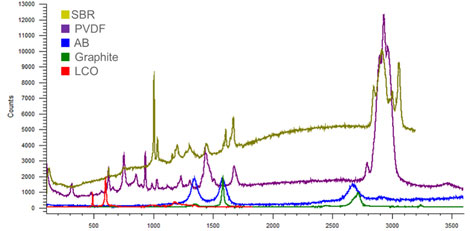
Detect and identify all materials present, even those at low concentration. These spectra were acquired in situ from: SBR (styrene-butadiene rubber, binder); PVDF (polyvinylidene fluoride, binder); AB (acetyl black, anode); graphite (anode); LCO (lithium cobalt oxide, cathode).
Determine Distribution and Structure
With Raman mapping and imaging, you can study the distribution of materials on electrode surfaces and on cross-sections. This enables correlation of composition and structure with device performance. Discriminate between spatially close components, and detect structural changes.
The data can be quantified to give you useful metrics such as fraction estimates and particle statistics.
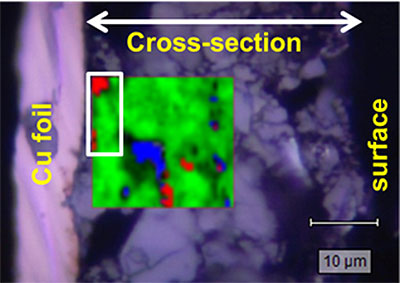
Detecting low concentrations of binder. Raman map of an anode (superimposed on an optical microscope image). Red – SBR styrene-butadiene rubber binder; Green – graphite; Blue – acetyl black. Relative concentrations determined by the map: 1%, 97% and 2%.
In Situ Electrochemical Characterisation
A wide range of sample chambers, electrochemical cells and inert gas glove boxes can be used with the Renishaw InVia for in situ analysis. Data acquisition can also be triggered by other devices, including potentiostats, for in situ and operando measurements.
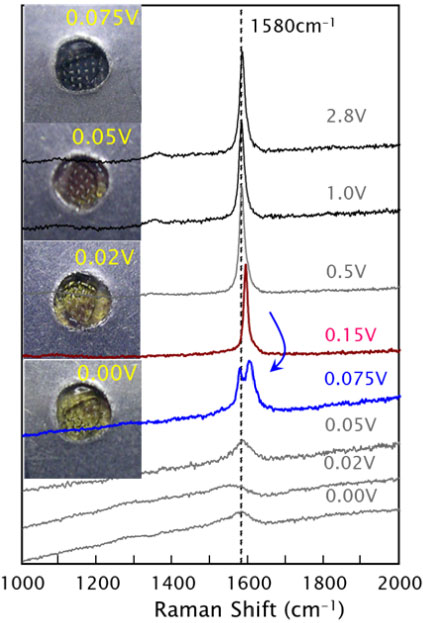
Operando studies of an anode. As the potential changes, the
anode’s appearance changes. The graphite G-band Raman peak also
changes, indicating intercalation of lithium (shifting the peak to higher wave numbers). The peak-splitting indicates the intercalation penetrating the interior layers, rather than just boundary layers. Courtesy of Prof. Y. A. Kim, Shinshu University.
No Sample Damage
The components of lithium-ion batteries can be affected and damaged by high laser power densities. The InVia has line-focus laser illumination technology to reduce power densities and prevent sample damage. The total laser power is maintained, giving you the same high quality data at high speeds, without altering your sample.
Sensitivity
With the inVia you can detect materials that are present even at low concentrations, such as binders, with high sensitivity and spatial resolution.
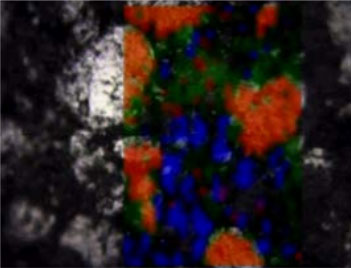
Raman map of an anode, superimposed on an optical microscope image. Red – graphite; Blue – acetyl black; Green – hard carbon. Relative abundances: 13%, 10% and 77%.
Correlated Information
Raman can be combined with AFM (Atomic Force Microscopy) to give you:
- Chemical information from Raman spectroscopy
- Correlated surface topography information from AFM
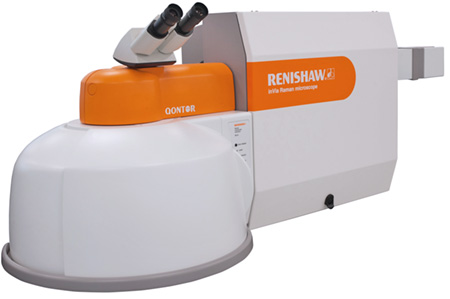
Renishaw InVia
The InVia is a research-grade Raman microscope, ideal for battery research:
- Highly sensitive, for detecting traces of materials
- High confocality for studying small details
- Range of rapid mapping and imaging modes
- Automation options, including triggering data acquisition with external devices such as potentiostats
- Raman-compatible electrochemical test cells available
Further Information
Blue Scientific is the official Nordic distributor for Renishaw Raman and AFM-Raman. If you have any questions or if you’d like a quote, please get in touch:


